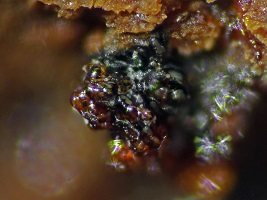
Locality: Oliver Trench, Moat Mnt., Hale's Location, NH
Specimen Size: 0.5 mm field of view
Field Collected: Bob Janules
Catalog No.: u2287
Notes: Bob Janules suggested pitticite. The mindat.org formula is given as: (Fe, AsO4, H2O) (?)
These globules are on altering lollingite or arsenopyrite.
Mindat indicates pitticite is:
"An amorphous Fe3+ hydrous arsenate sulphate of questionable validity. Chemical composition appears to be variable."
"Microprobe analyses of 7 pitticites from various localities indicate that it is a gel-like mineral of widely varying composition with no apparent stoichiometry.
Previously reported minor amounts of Si, Ca, P and Al are constituents of pitticites but are non-essential. Pitticite is retained as a generic name for amorphous, gel-like, ferric iron arsenate minerals of varying chemical composition. (P. J. Dunn (1982) New data for pitticite and a second occurrence of yukonite at Sterling Hill, New Jersey. Mineral Mag., 46, 261-264.)"
An Oct. 2019 EDS analysis, normalized for one Fe (BC338) gave FeAs0.6,K0.1O15
Checking with a B&L poloarizing microscope confirmed these globules are amorphous.
Searching the IMA data base for minerals with BC338 analysis chemistry (including H) yields 15 candidates. None of these are pitticite, because I assumed both the Fe and As were "essential" elements to the mineral's composition. I am convinced Bob's identification is correct. This is an excellent example of an experienced collector's intuition for a correct identification.
These lustrous jelly balls are impossible to photo without bright reflections. This photo is the best of four attempts. There are a few mm of these globules on the specimen, but larger area photos are much worse. Sort of like trying to take a photo a group of silver garden balls in sunlight.
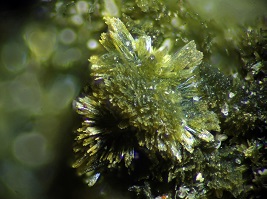
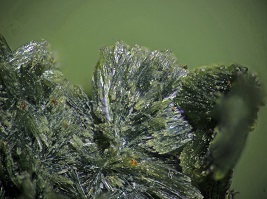
Locality: Industrial Interchange road cut, Merrimack, NH
Specimen Size: 1 mm field of view top photo, 1.5 mm field of view lower photo
Field Collected: Tom Mortimer - 1990's
Catalog No.: 1150
Notes: Pumpellyite species indicated by EDS analysis, normalized for 3 Si.
APFU from 1st probing: Ca2.45Fe0.35Al2.61Si3O9.3 Fe + Al + Mg = 2.96
APFU from 2nd probing: Ca2.41Fe0.53Mg0.21Al2.30Si3O13.6 Fe + Al + Mg = 3.04
The IMA (2019) lists five "flavors" of pumpellyite: pumpellyite-(Al), pumpellyite-(Fe2+), pumpellyite-(Fe3+), pumpellyite-(Mn2+), pumpellyite-(Mg).
The chemistry of pumpellyite has evolved over the years. Deer, Howie & Zussman An introduction to Rock Forming Minerals, 1966, gave a formula that required Mg as an esential element:
Ca4(Mg,Fe2+)(Al,Fe3+)5O(OH)3[Si2O7]2[SiO4]2 · 2H2O .
The 2019 IMA references an earlier formula for pumpellyite-(Fe3+) of:
Ca2(Fe3+,Mg)Al2(Si2O7)(SiO4)(OH,O)2 · H2O , allowing some Mg substitution for Fe.
Encyclopedia of Minerals, 1989, lists the pumpellyite group with general formula:
Ca2X(Y2)(SiO4)(Si2O7)(OH)2 · H2O
Where X = Al, Fe2+, Fe3+, Mg: Y = Al, Fe3+, Al, Cr3+ , indicating the Al can be allocated to both the X and Y sites. X + Y = 3
Encyclopedia of Minerals, 1989, lists pumpellyite as:
Ca2MgAl2(Si2O7)(SiO4)(OH)2 · H2O , with no Fe and requiring Mg,
but also lists a "pumpellyite-(Fe) (Ferropumpellyite)" as:
Ca2Fe2+Al2(Si2O7)(SiO4)(OH)2 · H2O
Fleicher's 2008 Glossery gives a pumpellyite-(Fe3+) formula as:
Ca2Fe3+Al2(SiO4)(Si2O7)(OH)2 · H2O
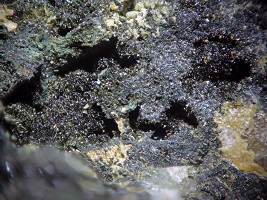
Locality: Chickering Mine, Walpole, NH
Specimen Size: 5 mm field of view. Micro-crystaline frondelite
Field Collected: Tom Mortimer
Catalog No.: TBC
Notes: The rockbridgeite-frondelite series presents substantial difficulties for the amateur mineral collector. Ignoring oxidation states, end member frondelite is MnFe4(PO4)3(OH)5 and
end member rockbridgeite is Fe5(PO4)3(OH)5. Dana's System of Mineralogy, seventh edition, provides analyses that indicate ferroan frondelite and manganoan rockbridgeite exist, blurring species definitions. A frondelite formula including oxidation states is given as (Mn2+,Fe2+)Fe3+4(PO4)3(OH)5. Dana continues, "Divalent manganese and iron [tm, the Mn2+ & Fe2+ in the formula] substitute mutually and probably a complete series extends between the manganese and iron end-members.The names frondelite and rockbridgeite are applied to the halves of the series with Mn2+ > Fe2+ and Fe2+ > Mn2+ respectively."
A Dec. 2019 EDS analysis (BC368A) suggested this Chickering sample is frondelite, although the computed chemistry is not an optimal fit.
An APFU normalized for 3 P yields Mn0.49Fe3.13P3O13.
An APFU normalized for Mn + Fe = 5 yields Mn0.68Fe4.3P4.1O17.9. (The P is high). With some "leap of faith", if we assume four of the 4.3 Fe are Fe3+ and the remaining 0.3 Fe is 2+ , Then we have (Mn2+0.68,Fe2+0.3)Fe3+4P4.1O17.9 . This would fit the Dana frondelite definition with Mn2+ > Fe2+.
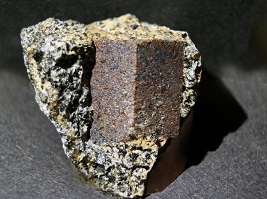
Locality: Pearl Lake Locale, Lisbon, NH
Specimen Size: 1.5 cm staurolite crystal in matrix
Field Collected: Tom Mortimer
Catalog No.: 992
Notes:
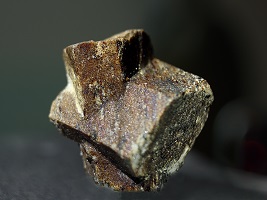
Locality: Pearl Lake Locale, Lisbon, NH
Specimen Size: 2.4 cm staurolite crystal penetration pair
Field Collected: Tom Mortimer - Sept. 2001
Catalog No.: 1368
Notes:
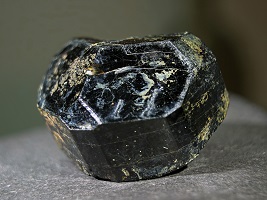
Locality: Rice Mine, N. Groton, NH
Specimen Size: 3.2 cm complete, double-terminated, schorl crystal
Field Collected: Leroy Grant - 1970's
Catalog No.: TBC
Notes:
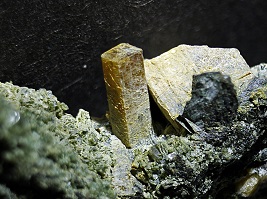
Locality: Joppa Hill, Amherst, NH
Specimen Size: 8 mm terminated scapolite crystal
Field Collected: Tom Mortimer
Catalog No.: 775
Notes: Candidate scapolite crystals from the Joppa Hill Locale have been analyzed to be feldspar pseudomorphs. This one appears quite pristine.
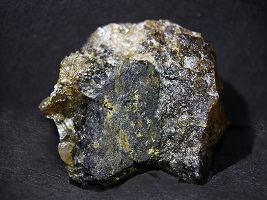
Locality: Valencia Mine, N. Groton, NH
Specimen Size: 2.5 cm specimen with 1.5 cm altered triphylite crystal
Field Collected: Tom Mortimer
Catalog No.: 1608
Notes: Triphylite is likely altered to mostly ferrisicklerite, but visible small cavities have other alteration products. The yellow mineral may be stewartite. The Valencia Mine is the only NH locality where I have seen euhedral altered triphylite crystals with visible micro phosphates included.
The Chandlers Mill Mine in Newport, NH has produced the "worlds best" triphylite crystals, but all examples from this locality are un-altered. I acknowledge the Palermo Mine in N. Groton has huge altered triphylite crystals, but most of these altered single crystals would fill the bed of a pick-up truck.
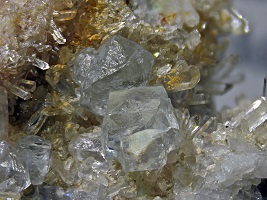
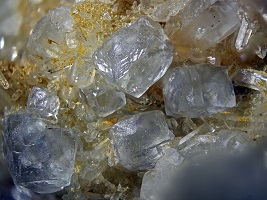
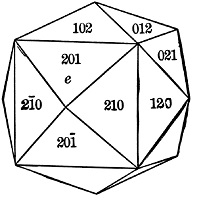
Locality: Stoddard Mine, Westmoreland, NH
Specimen Size: 2 to 3 mm fluorite crystals
Field Collected: Tom Mortimer
Catalog No.: 1298
Notes: I call these fluorites "ice cubes." The crystal form is a tetrahexahedron, somewhat uncommon. Due to lack of contrast with the adjacent milky quartz crystals, they are most difficult to photograph. These images compare favorably with the best of this habit on mindat.org from Stoddard.
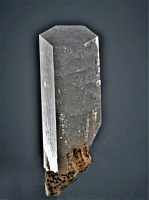
Locality: The Ravine locale, Moat Mtn, Bartlett, NH
Specimen Size: 2.1 cm crystal
Field Collected: Bob York
Catalog No.: Don Dallaire collection and photo
Notes:
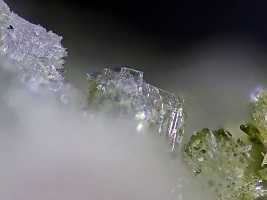
Locality: Palermo Mine, N. Groton, NH
Specimen Size: 0.25 mm crystal cluster - VERY tiny!
Field Collected: TBD
Catalog No.: A Arnaldo Brunetti collection specimen
Notes: I made three tries at this. Very tiny, 0.25 mm cluster. Stacked square-ish plates. Visual ID is foggite. The terminations are square with the vertical, but appear rhombic in this somewhat tilted view. If foggite, then a respectable photo of distinct crystals. Stack of 50 images, SL3 with Canon 55-250 mm lens plus Nikon Plan 10 objective.

Locality: Madison Lead Mine, Madison, NH
Specimen Size: 0.1 mm crystal - VERY tiny! with green pyromorphite
Field Collected: Bob Janules, ex Vince Valade
Catalog No.: u437
Notes: This is a redo of a November 2015 photo taken with my Canon G9 and Meiji trinocular scope. Stack of 8 images, Canon SL3 camera with Canon 55-250 mm lens plus Nikon Plan 10 objective. This is a very substantial improvement. Although mindat.org reports wulfenite from the Madison Lead Mine, this is the only specimen I have seen from this locality.